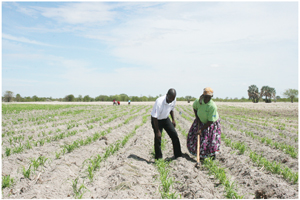
Conservation Agriculture produces early mahangu germination in Oshana region

Maria Stefanus seen weeding her ripped furrowed mahangu field where mahangu plants are already 25 cm tall, while Tuyakula Nantinda, NCAP Field Coordinator for Oshana region, is advising on the thinning of seedlings.(Photograph contributed)
This is evidence from a technique called Conservation Agriculture (CA), a method developed in 2005 which boosts average mahangu yields to 1670 kg/ha.
CA relies on a simple set of techniques that have been developed together with communal mahangu farmers in the Namibian context. The technique not only improves yields but stabilises them over time by mitigating against climate change impacts.
According to Stefanus, she first heard of the technique through a radio announcement for a meeting regarding the technique by her councillor earlier this year.
“I decided to attend as I am in dire need of improving my crop yields. In the meeting, Tuyakula Nantinda from the Namibia Conservation Agriculture Project (NCAP) informed (us) about the project and the CA methods – the ripper furrowing and hand-hoe basin – used to promote and assist farmers with. He also explained about soil degradation, outdated farming methods, climate change impacts, and why our yields are declining because of all these factors,”she said.
Stefanus soon approached NCAP to register as a Lead Farmer and has since attended a NCAP course on CA where she learned about basic crop and soil science.
As a NCAP Lead Farmer she will hold four, on-farm trainings per year on CA theory and practice including correct planting, manure and fertilizer application, and also post-harvest activities such as crop residue retention for soil cover, storage of grain, treatment of seed and marketing. She is getting back-up support from the NCAP Field Trainers.
Stefanus claims that during her training, she realised that she and fellow farmers had been practising outdated farming methods. Old traditional farming methods of disc harrowed have now been replaced by ripped furrowed instead.
The ripper furrower method is a Conservation Tillage technique within the wider scope of CA. A ripper tine cracks open the compacted plough pan, allowing for deep root penetration, while wings fitted on the tines create furrows that guide rain water to the planting lines, thus creating in-field rain water harvesting. The method is suitable in drought as well as flood conditions since with the plough pan broken, the water now can seep into the soil like a sponge.
“The NCAP Field Coordinator arranged for a private service provider to rip furrow my land at the end of October. I planted immediately from my own mahangu seed storage and a few days later I received showers. By the beginning of November the mahangu had already germinated. Early land preparation and planting is vital, especially with the unreliable rains and recurring floods we encounter nowadays. It is important that your plants are tall and healthy as early as possible in order to withstand possible drought or flood.”
NCAP is a three year CA project implemented by CLUSA International in seven northern regions of Namibia. It is funded by the United States Agency for International Development (USAID).
“The interest from farmers to join the project is overwhelming. We are already collaborating with 330 Lead Farmers who in their turn have registered close to 7000 of their neighbours for on-farm CA trainings. NCAP is virtually a training project where Lead Farmers are capacitated to make an impact in their communities in the interest of national food security and in reversing soil degradation”, said Richard Shikongo, NCAP Coordinator for CLUSA.
He further stated: “Judging by the interest from the farmers there is a huge opportunity for the private sector to offer ripper furrowing land preparation services in the communal land farming areas by tractor as well as draught animals. Seed and fertilizer outlets that are accessible for smallholder farmers as well as post-harvest mechanized threshing services are also very much needed. I firmly believe that subsistence farming can develop into sustainable semi-commercial enterprises if environmentally friendly CA methods are applied, thus northern Namibia – from Zambezi to Kunene – should be seen in the light of a positive investment climate in the agriculture service sector.”
Maria Stefanus concluded: “This is the best my crops have ever looked this time of the year and I am optimistic that this could be my best crops ever. I am looking forward to harvest time and how my farm improves under these new Conservation Agriculture techniques.”










































